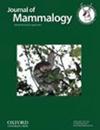Unraveling the complex biogeographic and anthropogenic history of mountain goats (Oreamnos americanus) in Alaska
IF 1.6
3区 生物学
Q2 ZOOLOGY
引用次数: 0
Abstract
Both natural and anthropogenic forces can play a substantial role in the demographic history and current structure of a wildlife population. Species with strict habitat requirements are especially susceptible to these impacts. Mountain goats (Oreamnos americanus) in Alaska are of particular interest in this regard due to their influence on alpine ecosystems, importance to human cultures, and enigmatic history in some areas. Here, we used genetic tools to examine the population structure and demographic history of mountain goats in Alaska. We genotyped 816 mountain goats at 18 microsatellites, identified the number of genetically distinct subpopulations, and assessed their genetic diversity. We used Bayesian methods to investigate demographic history relative to the known geologic and human history of Alaska, and we simulated human-mediated translocation events onto islands to address the hypothesis that Baranof Island harbored an extant population prior to an early 20th-century introduction. We showed that Alaska has 4 genetically distinct subpopulations of mountain goats. The main demographic split between Southcentral and Southeast Alaska occurred following the retreat of ice after the Last Glacial Maximum. Simulations of translocation events largely aligned with expected genetic diversity patterns of current subpopulations except for Baranof Island which showed greater diversity than the simulation, consistent with the hypothesis of an endemic population prior to the translocation. This study highlights the value of considering both natural and anthropogenic forces when assessing the biogeographic history of a species and provides new insights about the complex demographic history and biogeography of mountain goats in Alaska.揭示阿拉斯加山羊(Oreamnos americanus)复杂的生物地理学和人类活动史
自然和人为力量都会对野生动物种群的人口历史和当前结构产生重大影响。对栖息地有严格要求的物种尤其容易受到这些影响。由于阿拉斯加的山羊(Oreamnos americanus)对高山生态系统的影响、对人类文化的重要性以及在某些地区神秘的历史,它们在这方面尤其值得关注。在这里,我们利用遗传工具研究了阿拉斯加山羊的种群结构和人口历史。我们在 18 个微卫星上对 816 只山羊进行了基因分型,确定了不同基因亚群的数量,并评估了它们的遗传多样性。我们使用贝叶斯方法研究了与阿拉斯加已知地质和人类历史相关的人口统计历史,并模拟了由人类促成的迁移到岛屿的事件,以解决巴拉诺夫岛在 20 世纪早期引入山羊之前曾有一个现存种群的假设。我们的研究表明,阿拉斯加有 4 个遗传上截然不同的山羊亚群。阿拉斯加中南部和东南部的主要人口结构分裂发生在末次冰川极盛期后的冰川退缩之后。除了巴拉诺夫岛(Baranof Island)比模拟结果显示出更大的多样性外,迁移事件的模拟结果与当前亚群的预期遗传多样性模式基本一致,这与迁移前地方性种群的假设一致。这项研究强调了在评估一个物种的生物地理历史时同时考虑自然和人为因素的价值,并为阿拉斯加山羊复杂的人口历史和生物地理学提供了新的见解。
本文章由计算机程序翻译,如有差异,请以英文原文为准。
求助全文
约1分钟内获得全文
求助全文
来源期刊

Journal of Mammalogy
生物-动物学
CiteScore
3.30
自引率
5.90%
发文量
106
审稿时长
4-8 weeks
期刊介绍:
Papers are published on mammalian behavior, conservation, ecology, genetics, morphology, physiology, and taxonomy.
 求助内容:
求助内容: 应助结果提醒方式:
应助结果提醒方式:


